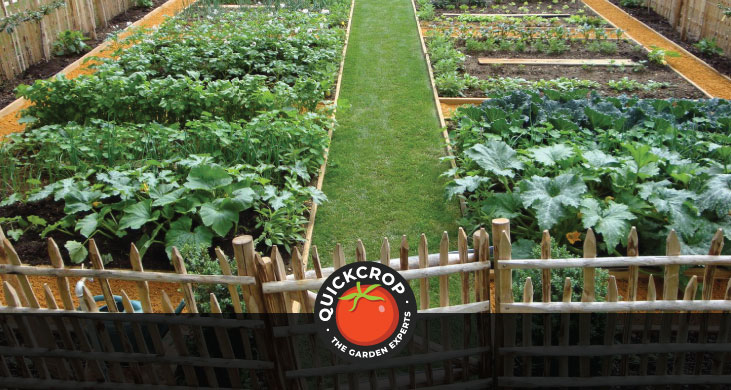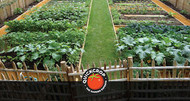French Intensive Gardening

‘French Intensive Gardening’. Sounds kind of daunting, who wants gardening to be intensive? Me, I like to do a little burst of work here and there and take it easy on myself. But you shouldn’t read too much into a title, so let’s delve a bit deeper into the practice.
Firstly, the name comes from the fact that this gardening method was heavily used in French markets, where the use of ‘double digging’ (more on this below), wind blocks and fermenting manure allowed growers to cultivate high vegetable yields from small, compact spaces. These plots were shown to have great productivity even during traditionally poor seasons.
Fear not, because you don’t need piles of fermenting manure to hand if you’re interested in practising this method in your home garden. French Intensive Gardening has been adapted by many grow-your-own enthusiasts, even if it’s just taking a couple of the main principles and seeing some success. Alan Chadwick is one of the more influential champions of intensive gardening as well as the closely-related concept of biodynamic gardening, a holistic and eco-conscious approach. Chadwick was, as the saying goes, a bit of a character. His story is far too interesting to go into in depth here, but one amusing part of it was how he established a garden at the University of California and before long the students started dropping out of their courses to join him in the garden!
John Jeavons’ book How to Grow More Vegetables is also regarded as a key text. (How to Grow More Vegetables (And Fruits, Nuts, Berries, Grains, and Other Crops) Than You Ever Thought Possible on Less Land with Less Water is its hilariously long full title).
French Intensive Gardening shares a lot of similarities with another technique that we’ve discussed on the blog, Square Foot Gardening. Like the latter, it involves planting vegetables more densely than usual, with the intention of making the most of small spaces. However, whereas Square Foot Gardening makes use of a ‘grid’ system for arranging different plants, with F.I.G. (going to have to start abbreviating here for brevity’s sake) you still plant in rows, allowing plant foliage to be packed closely in together.
Related Article: New Square Foot Garden Plans
With French Intensive Gardening, beds are designed to be no more than four feet wide. This is primarily to avoid compaction of the soil. A key factor in the long-term performance of an ‘intensive bed’ is that the soil is undisturbed as much as possible (after that initial bout of digging that is!). Walking, kneeling or treading on the soil tends to lead to compaction, which is where soil particles are pressed together. A width of 4 feet allows you to easily reach across and access the bed from all sides, whether you’re tending to plants, weeding or harvesting.
Some Key Features of French Intensive Gardening
Some of the main pillars of this gardening method include:
- Double Digging
- Close Spacing of Plants
- Intercropping
- Relay Cropping
- Succession Planting
- Crop Rotation
Double Digging
French Intensive Gardening is something of a long game. It involves a not-inconsiderable amount of work and planning in the early stages, but the idea is that it pays off in the long-term with a fertile garden and healthy yields. A key task at the early stage of planning your garden is what’s known as double digging. This involves digging the topsoil firstly, which is removed and set aside. The subsoil underneath is then loosened with a tilling fork or broadfork. Compost or manure is added as the top soil is then replaced. Overall this will create a well-aerated soil that drains well. The soil needs to be dug to a depth of roughly 18 inches to 2 feet.
As you break up the top layers of soil ((start digging the second layer)), you will also be periodically adding and mixing in good quality organic compost or broken down manure. Amending the soil as you go improves the overall composition and structure, which is important after all the digging and disruption.
An effective way to go about this task is taking your bed area step by step using small ‘grids’. As you remove the topsoil from one grid, place the soil in a pile to one side. Therefore when you remove the topsoil from grid 2 you can shovel this soil into grid 1, and so on.
The theory with breaking up the soil this way is that it allows plants to grow further down into the soil, as opposed to competing with neighbouring plants for nutrition. (This theory raises a couple of questions, as it is the upper layers of the soil that tend to have more nutrients - so it’s debatable, in my opinion, as to whether this is a real advantage of double digging or just something that plants adapt to). Giving plant roots more room to grow vertically is key to creating the conditions where they can be planted very closely together. In an average garden, the deeper layers of soil tend to be hard and compacted, which means that roots will not travel beyond a certain point whether or not they’d like to.
Furthermore, the recommended digging depth means that F.I.G. can be challenging to recreate in raised beds - although it can be done, and indeed the French market conditions mentioned earlier involved growing in containers.
Dense Planting
The idea with intensive gardening is to plan or plant in a way that leaves as little bare soil as possible. This isn’t just about space maximisation either. It’s an approach that can theoretically lead to more efficient use of nutrients, and means that you will be spreading your compost over a lesser area.
Another factor is that as plants mature and foliage begins to grow ever more densely, leaves will be brushing up against each other, in effect creating a kind of organic ceiling. This natural canopy was referred to as the ‘conservatoire’ or greenhouse by Chadwick. It can protect plants and the soil from extreme weather, discourage the growth of weeds, and retain moisture within the vegetable bed.
Intercropping
If you’re someone with a knack for organisation and attention to detail, then you may really like this part. With French Intensive Gardening, a common technique is to plant vegetables in the same space, at times using a kind of ‘yin and yang’ approach. Examples include:
- Intercropping fast growing plants with slower growing plants
- Tall plants and compact plants: Tall growing crops can cast some natural shade on shorter crops that appreciate protection from strong sun. The technique also lends pleasing aesthetic patterns to the vegetable garden
- Deep rooted and shallow rooted plants: this can lessen competition for soil nutrients
- Heavy feeders (tomatoes, peppers) and light feeders (lettuce, radish)
- Growing pollinator friendly plants with other plants that require pollination
How this works out in practice can differ according to the crops, but with experience you can tell the best intercropping method. Intercropping is closely related to companion planting, and both terms are sometimes used interchangeably. More specifically, companion planting takes into account symbiotic relationships between crops, whereas intercropping can involve other considerations like space and comparative growth rates.
Another sub-type of intercropping is known as ‘ relay cropping’: this very clever approach involves planting a second crop in the same space as the first before the first has reached the harvesting stage. It’s a super-efficient use of space and a way to maximise your yield - instead of waiting for the space to open up in your plot, you help your vegetable bed to ‘double task’. An example to illustrate: if you plant radishes in between rows of carrots, they will grow quickly and be ready to harvest before the carrots have fully matured.
On the subject of radish, it’s a very good crop when it comes to loosening and cultivating soil for other (slower-sprouting) vegetables to benefit from; much of this is to do with the crop’s taproot, which naturally discourages soil compaction.
Companion planting is often used for pest control or deterrence, such as planting strongly-scented herbs beside vulnerable crops. It’s also employed because certain plant pairings are known for growing well together, whether it’s because of enhanced flavour or growth.
Some pairings that you’ll find recommended can be hit and miss, and it really depends on your own personal experience in the garden. There are so many things that can influence whether or not a plant will grow well (whether on its own or in the company of others) that it would be misleading to just come up with a list of ‘Good Companion Plants’. Really, it’s all about figuring out what works for you in the garden through experience and observation.
Succession Planting
Basically, succession planting is the practice of keeping things humming along in the vegetable bed(s) at all times by quickly filling empty spaces. Once one crop has been harvested, you should have another one ready and waiting to take its place. As you can imagine, this involves a fair bit of forward planning, a good knowledge of plant requirements and a keen sense of timing. The reward for all this will be continuous harvesting and plentiful yields.
Succession planting can be easier and more effective if you practice transplanting as opposed to sowing from seed. Transplanting is where you use young plug plants or seedlings that have been started in a container. The advantage of this approach is that young plants are better established when you transfer them to the soil. They are also likely to have more succesful and reliable germination rates than if they were sown directly in the soil. Transplanting can require that you have a space undercover to propagate seeds and seedlings. This doesn’t necessarily have to be a polytunnel as an indoor windowsill with plenty of light and a heated cable or mat can work fine. Direct seeding remains the more suitable approach when it comes to root vegetables.
Some of the Disadvantages and Drawbacks of French Intensive Gardening
- Double digging can be fairly taxing work and is not for everyone. It can be especially difficult with drier clay soils or rocky soils. It becomes much easier in the long term, as the soil ecology settles and you no longer need to dig or work the soil.
- The method also requires some meticulous attention to detail and good knowledge of - or research of - the best plants to go with at different times. It can all be a bit ‘much’ to keep on top of; but if you’re passionate about gardening and have a knack for detail that might be all part of the fun.
- You may need to have more specialised garden tools to hand when it comes to the task of double digging.
As you may know, we at Quickcrop are big fans of the 'no dig' approach to vegetable gardening. While French Intensive gardening may be said to have the same long-term goal (leaving the soil unworked as much as possible and trusting in the natural fertility process), on some levels it's a different approach that we wouldn't be fully sold on.
Of course, like with other gardening methods you’ve read about on the blog, you can pick and choose from the techniques described above even if you’re not going to go the whole hog with double digging and so on. The whole intercropping aspect is a neat option to have in your bag of garden tricks, say.
